Quiz 1 ARC 362
1/77
There's no tags or description
Looks like no tags are added yet.
Name | Mastery | Learn | Test | Matching | Spaced |
|---|
No study sessions yet.
78 Terms
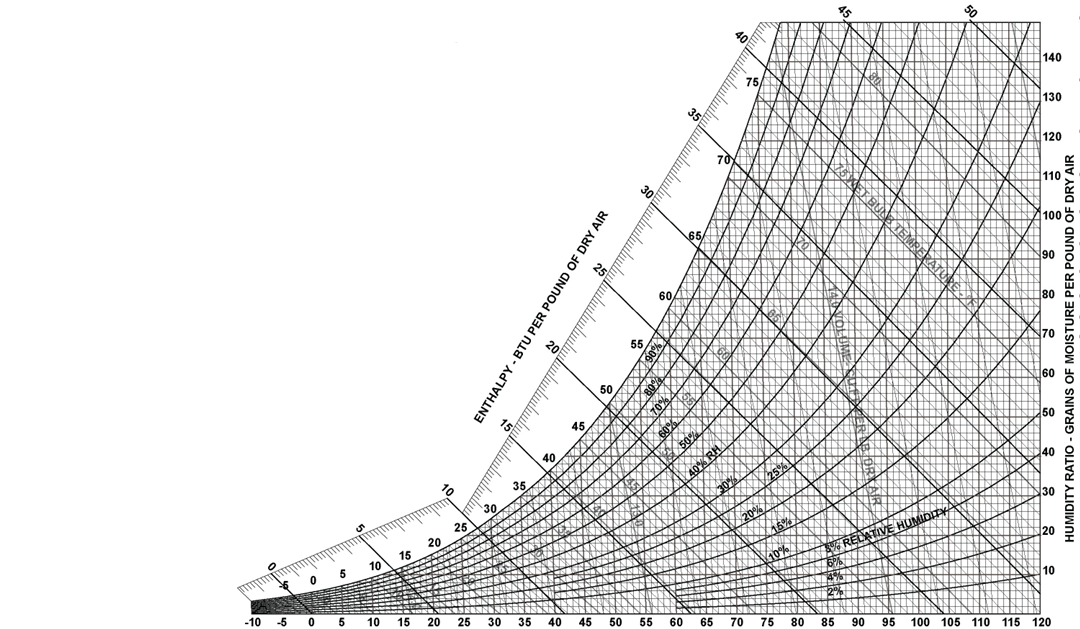
Psychometric Chart
represents physical and thermal properties of moist air
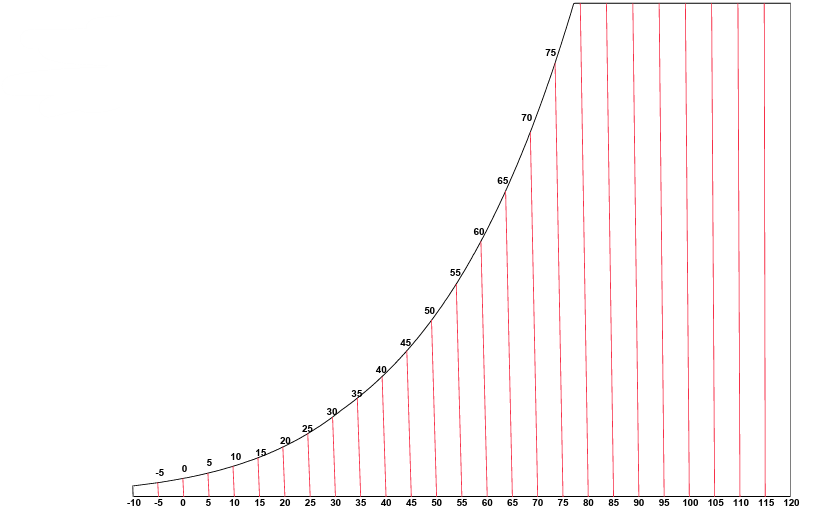
Psychometric Chart Horizontal Axis
Dry-bulb temperature scale = ambient air temperature (F)
Moving right means on chart
the air temp has risen (molecules moving faster), while left means its has fallen
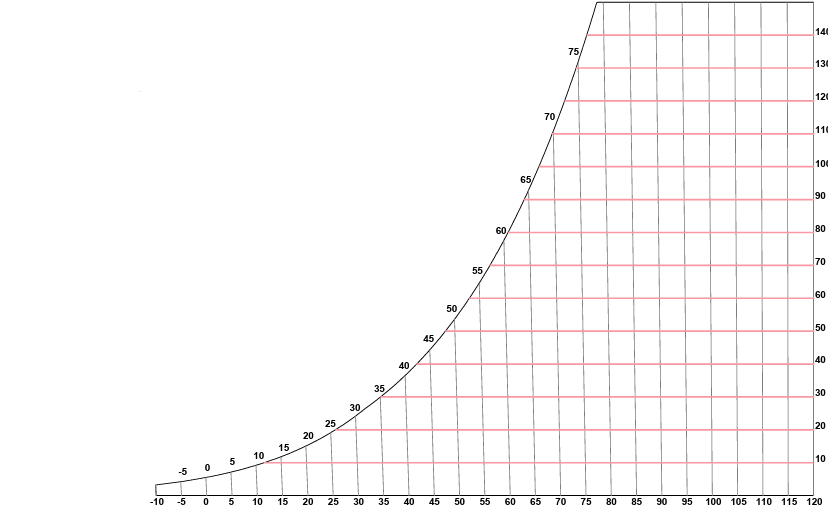
Psychometric Chart Vertical Axis
Humidity Ratio = grains of moisture per pound of dry air
Moving up indicates on chart
moisture being added to an air sample, while moving down means its been removed
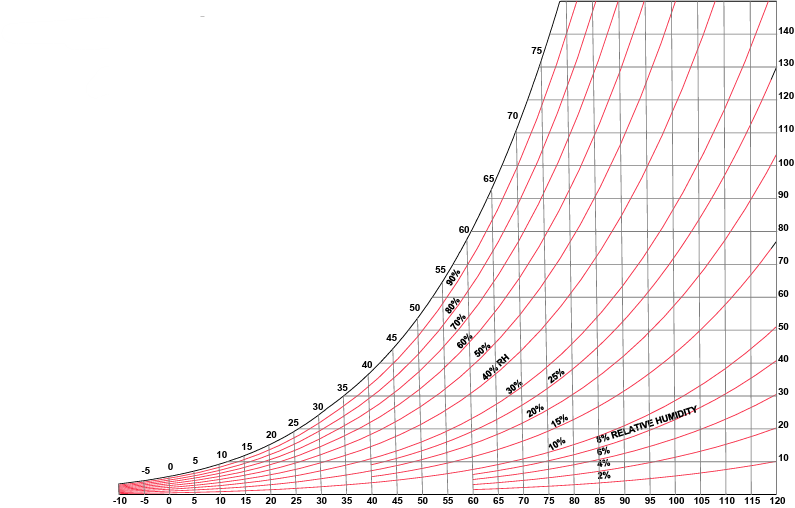
Psychometric Chart Diagonal Axis (to the Right)
Relative Humidity = how much water vapor is in the air compared to the maximum that could hold (%)
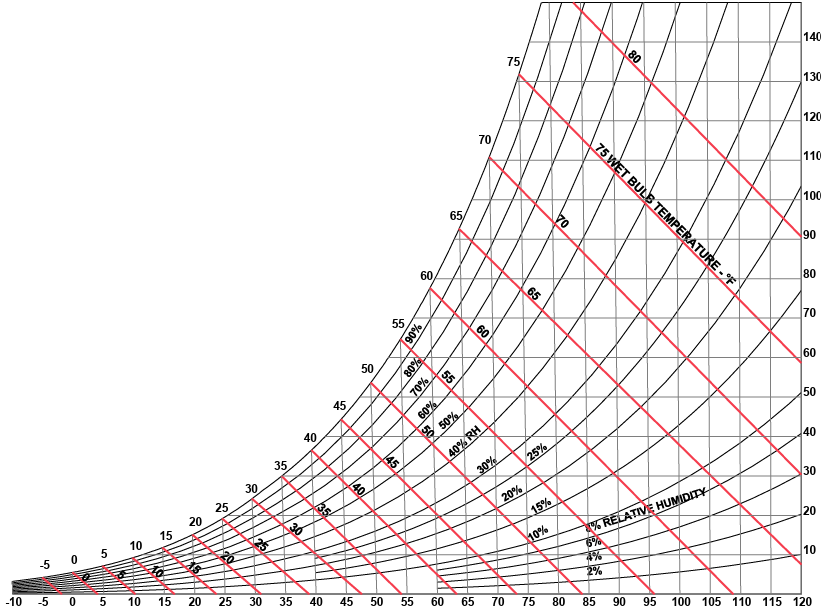
Psychometric Chart Diagonal Axis (where Diagonal Left meets Furthest Diagonal)
Wet Bulb Temperature = lowest temperature that can be reached under current ambient conditions by the evaporation of water only (F)
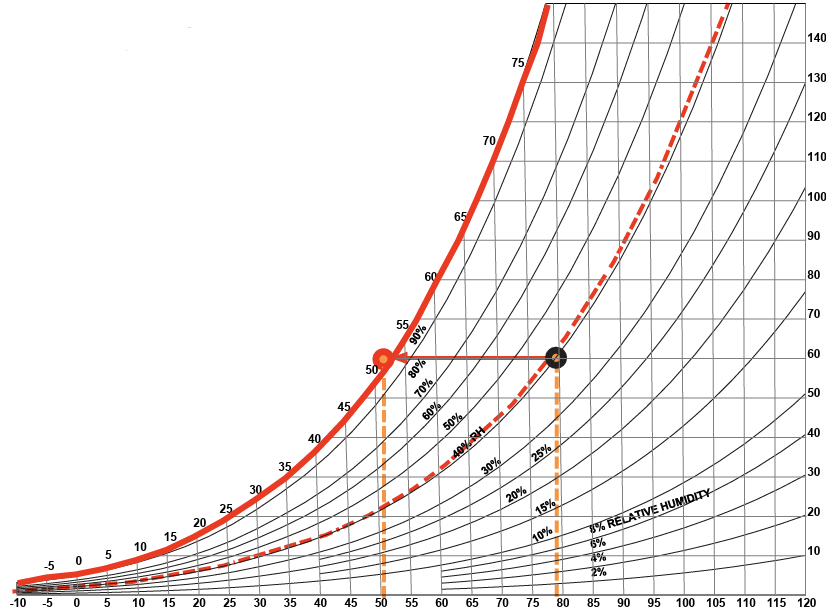
Psychometric Chart (where Horizontal Lines meet the Furthest Diagonal)
Dew Point = temperature at which the air becomes saturated with water vapor and condensation begins to for
Passive Strategies
leverage the inherent features of a side to regulate heating, cooling, light, and ventilation within a building
Passive Strategies to Warm a Building
Align bldgs to capture max. sunlight (northern)
High levels of insulation (thick walls)
Thermal mass for storing heat
Reducing the air flow out
Passive Strategies to Cool a Building
Shading (trees, awning, overhangs)
Natural Ventilation to circulate fresh air (cross or stacked)
Night cooling
Increase the air flow out
Active Strategies
a structure or system that either uses or is able to produce electricity itself (technology)
Active Strategies to Cool a Building
Air Conditioning
Using fans and pumps for ventilation and circulation
Evaporative coolers
Active Strategies to Warm a Building
Air Conditioning or Furnaces
Heat Pumps
Radiant Floor Heating
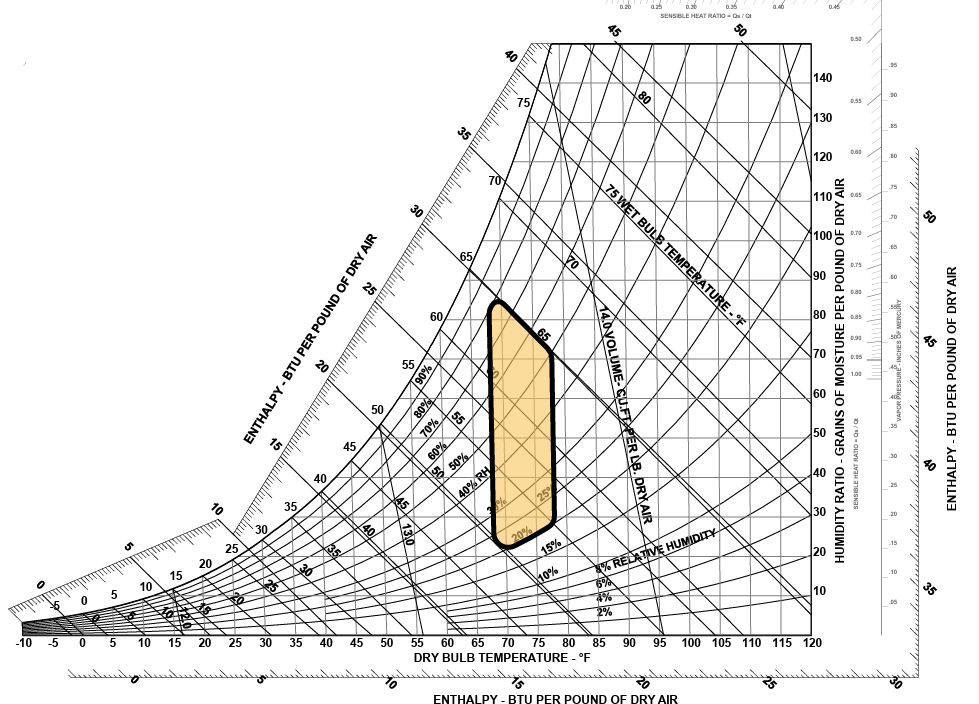
Thermal Comfort
as the bodily condition that expresses thermal satisfaction and wellbeing within the built environment; no corrective measures are needed once there
Biological Machines
Human Being; burns food as fuel and generates heat as a by-product —> heat loss and heat generated needs to be equal
Heat Loss
Radiation: emission of electromagnetic heat waves (usually hotter than enviro.)
Conduction: direct heat transfer from one object to another (holding a cold cup)
Convection: heat loss via rapid movement of air or water around us (cool breeze)
Evaporation: water evaporates off our skin (sweat)
Thermal Barriers
Clothing, Buildings, Mechanical Systems (HVAC)
Secondary Thermal Barriers
Micro-climates (Ex - Dome over Manhattan)
Metabolic Rate
the body’s speed at which it converts energy from food into heat and other cellular processes
Thermal Conditions of the Environment
Air temperature (F)
Relative Humidity (%)
Air movement (feet/min)
Mean Radiant Temperature (MRT)
Mean Radiant Temperature
average temperature of all the surfaces that surround a person, weighted by how much they radiate heat to or absorb heat from the person. It tells us how hot or cold a space feels due to radiant heat.
Why do we care about how heat transfers?
is crucial for creating sustainable, energy-efficient, and comfortable buildings
Specific Heat
amount of heat energy required to raise the temperature of one gram of a substance by one degree Celsius.
Conduction
heat is transferred between objects or substances in direct contact with each other
Convection
heat transfer through the movement of fluids (liquids or gases)
Radiation
heat transfer through electromagnetic waves, such as infrared radiation from the sun or a fire
Transmittance
radiation that passes through a material without being absorbed or reflected. Essentially, it’s a measure of transparency
Absorptance
radiation that is absorbed by a material. The absorbed energy is often converted into other forms of energy, like heat.
Reflectance
radiation that is reflected by a surface or material.
Emittance
This is a measure of how well a surface emits thermal radiation compared to a theoretical black body at the same temperature. It’s a ratio of the radiation emitted by a surface to the radiation emitted by a black body.
Equilibrium Temperature
temp at which the net heat flux is zero
Heat Sink
a device used to transfer heat from a heat source to the surrounding environment (example - roman vaults)
Thermal Resistance (R-Value)
measurement of a material's or a component's resistance to heat flow.
A higher R-Value means
that a material is a superior insulator, providing a better barrier against heat flow
Heat Flow Coefficient (U-Value)
rate of heat transfer per unit area per unit temperature difference across a material (inverse of r-value)
A higher U-Value means
that a material is a poor insulator, allows more heat to transfer through it
Time Lag
the amount of time it takes for heat to pass from the outside
The higher the thermal mass
the longer the thermal lag
Why do buildings use so much energy?
need to make buildings comfortable through the use of systems like heating, cooling, lighting, ventilation
Energy
capacity to do work or cause change, two categories:
Potential (chemical, nuclear, gravitational, elastic)
Kinetic (mechanical, electrical, thermal, electromagnetic, sonic)
Heat
energy in motion due to a temperature difference
Sensible Heat
heat you can feel, or sense. This is any heat which can be measured on a thermometer
Latent Heat
energy absorbed or released during a change of phase at a constant temperature
Radiant Heat
exchange heat by both convection and radiation with the environments they are designed to heat or cool
Heat
BTU - amount of work it takes to make the particles in a substance move faster
Temperature
Fahrenheit - temperature is a measure of the average kinetic energy of the particles within a substance
Heat Flow
BTU/ hour - indicates how much heat energy is transferred over a length of time
Embodied Energy
The total energy required for the extraction, processing, manufacture and delivery of building materials to the building site. Measured in megajoule (MJ) or gigajoule (GJ) per unit of material
Law 0 of Thermodynamics
if two objects have the same temperature as a third object, they must also have the same temperature as each other.
Law 1 of Thermodynamics
Conservation of Energy - energy can neither be created nor destroyed, only altered in form
Law 2 of Thermodynamics
Entropy - total entropy of an isolated system can only increase or remain constant in a process; cannot decrease
Law 3 of Thermodynamics
Entropy at Zero Temperatures - As the temperature of a system approaches absolute zero (0 Kelvin), the entropy (or disorder) also approaches zero.
Embodied Carbon
The carbon footprint of a material. It considers how many greenhouse gases (GHGs) are released throughout the supply chain and is often measured from cradle to (factory) gate, or cradle to site (of use). (measured in kilograms of carbon dioxide equivalent (kg CO2e) or tonnes of carbon dioxide equivalent (t CO2e)
Operational energy
the energy consumed during the building’s day-to-day use, encompassing heating, cooling, lighting, ventilation, and other energy- consuming activities.
Bioclimatic design
designing buildings and outdoor spaces based on the climate of the site, the sun’s path, prevailing winds, humidity, and seasonal variations—to reduce energy consumption and enhance occupant comfort.
Bioclimatic Design Steps
Exterior Forces act
Building form reacts to 1
Building envelope is the permanent construction of 2
Active systems inside of 3
Norbet’s 3-tier approach to sustainable design
Tier 3 = Mechanical Equipment (heating and cooling equipment, lighting, renewable energy)
Tier 2 = Passive Systems (natural energies, daylighting, ventilation, sunspace)
Tier 1 = Basic Building Design (heat retention, heat rejection, heat avoidance, location, site design)
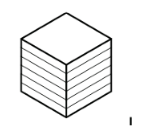
Building Form 1
The building layout limits optimal north-south window placement (-)
It offers minimal potential for natural lighting, passive solar heating, and passive cooling (-)
Compact design reduces heat transfer and land use, making it ideal for cold climates (+)
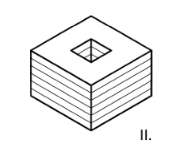
Building Form 2
Improves daylighting and ventilation, with more access to views, though some are limited to the atrium (+)
Limits optimal north-south window orientation, is less compact unless the atrium is enclosed, and requires a larger land footprint than Form I (-)
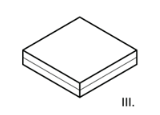
Building Form 3
Strong potential for passive solar heating and cooling using south-facing clerestories, roof vents, solar chimneys, and evaporative cooling, with minimal need for vertical circulation (+)
Requires a large land footprint and has a high surface-area-to-volume ratio, with limited optimal window orientation except for clerestories (-)
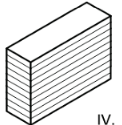
Building Form 4
Allows optimal window orientation for excellent daylighting, cross ventilation, and passive solar heating (+)
Higher surface-to-volume ratio and poor performance if long facades face east or west, leading to high cooling loads and poor daylighting (-)
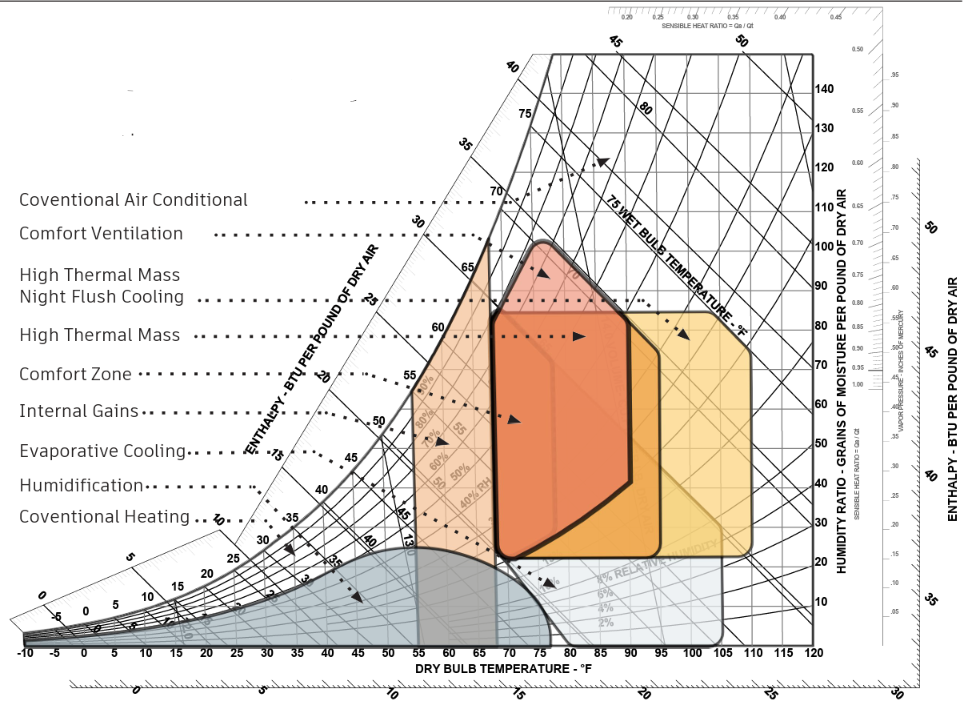
Coventional Air Conditional
Active strategy | Down and Left to TC- dehumidifying and cooling
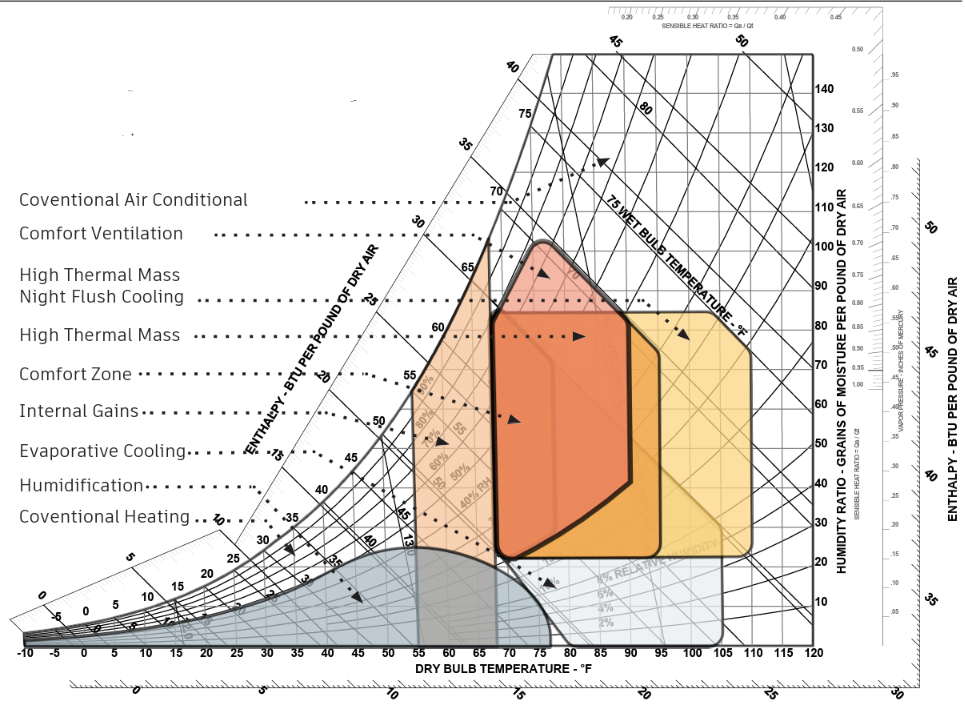
Comfort Ventilation
Down and Left to TC - dehumidifying and cooling (air movement)
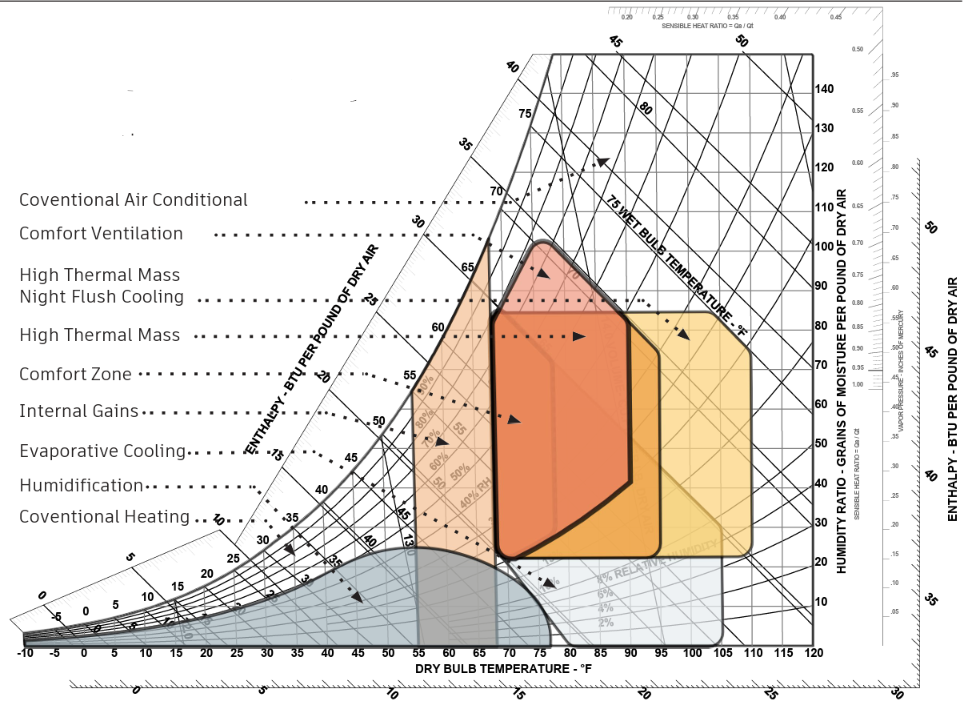
High Thermal Mass
Left to TC - sensible cooling (night flush cooling)
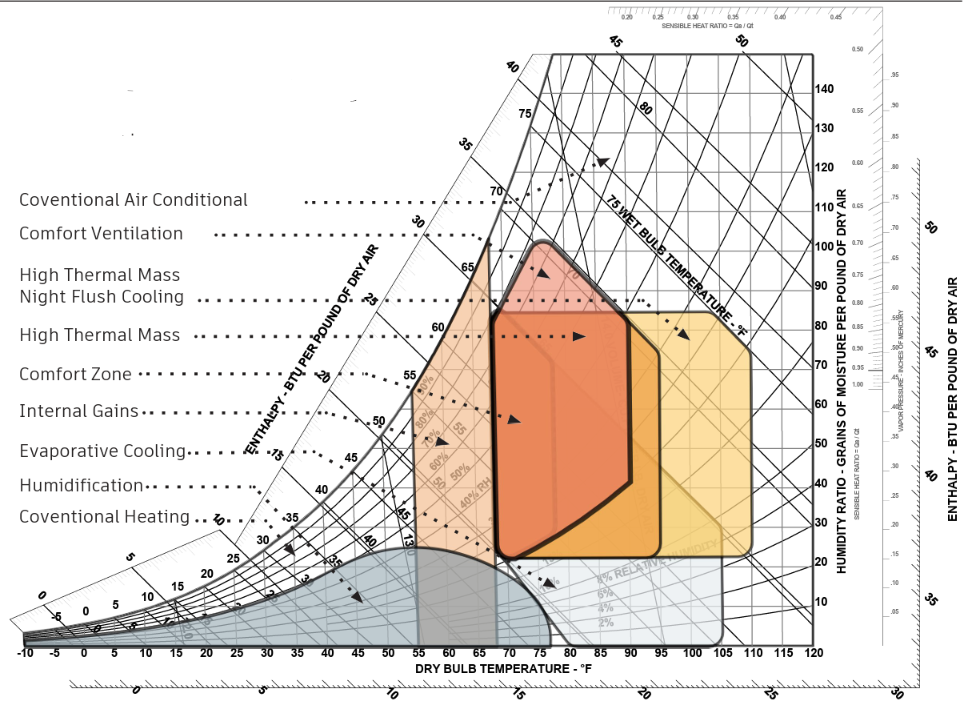
Internal Gains
Right and Up to TC - sensible heating (people, lights, and equipment)
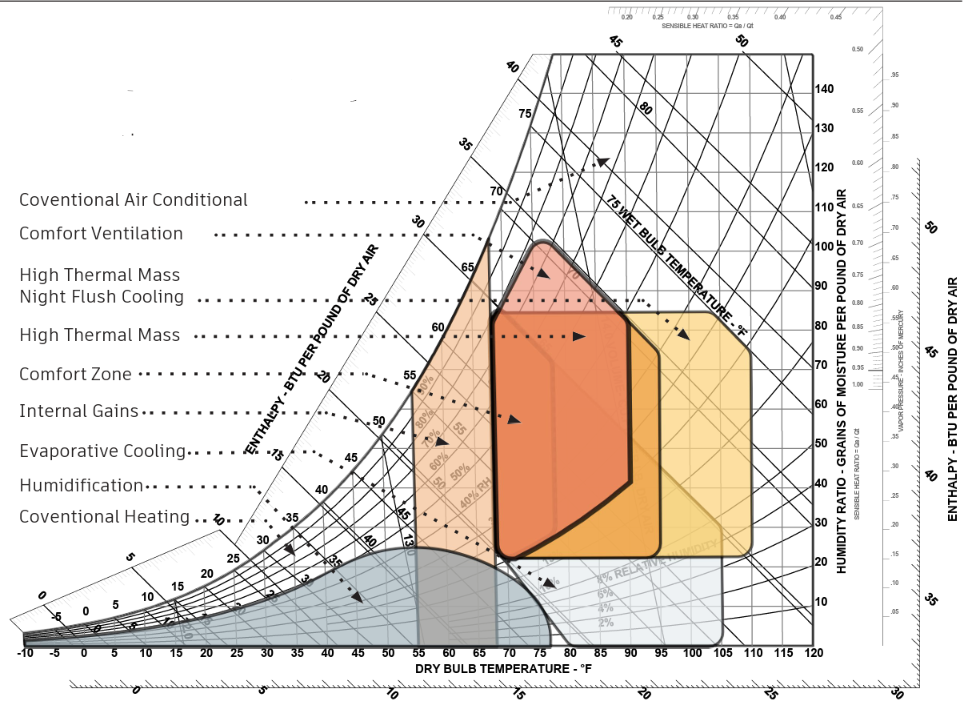
Evaporative Cooling
Up and left to TC - evaporative cooling
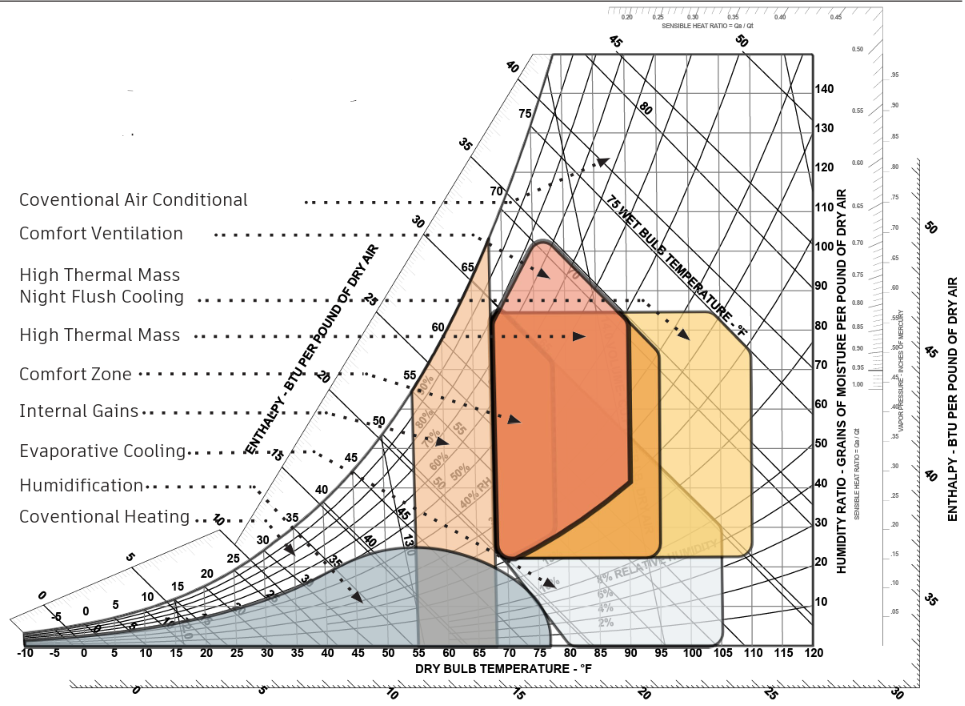
Humidification
Up and right to TC - heating and humidfying
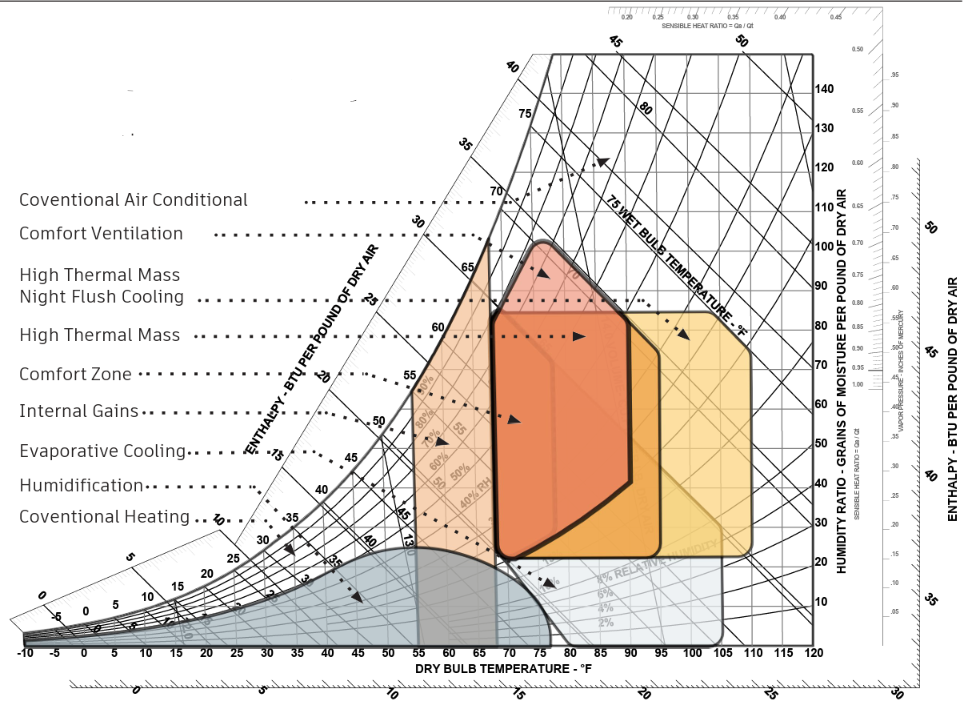
Conventional Heating
(Only Active Strategy) Up and right to TC - heating and humidfying
Heat Load
how much heat we have to add/remove to get to TC | External Load (climate) + Heat Loss/Gain (envelope) + Internal Loads (program)
Degree days
quantifies the difference between the daily mean temperature and a chosen base temperature (commonly 65°F in the U.S.) over a 24-hour period
IECC Climate Zones
0 = extremly hot (no US state)
1 = very hot and humid (extreme cooling)
2 = hot humid
3 = hot-dry climates
4 = mixed-humid (moderate heating and cooling)
5 = cold climate
6 = colder climate
7 = very cold climate
8 = subartic (extreme heating)
Koppen Climate Zones
A - Tropical
B - Dry
C - Temperate
D - Continental
E - Polar
Heat Island Effect
phenomenon where urban areas become significantly warmer than their surrounding rural areas, particularly at night, due to the replacement of natural land cover with buildings, roads, and other materials that absorb and retain heat
Enthalpy =
Sensible + Lantent Heat (total heat)
Basis of Design
outlines the reasoning, assumptions, and criteria behind architectural and engineering design decisions for a project, connecting the owner's needs with the technical design choices
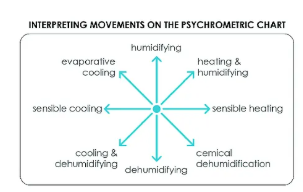
EXTRA 1
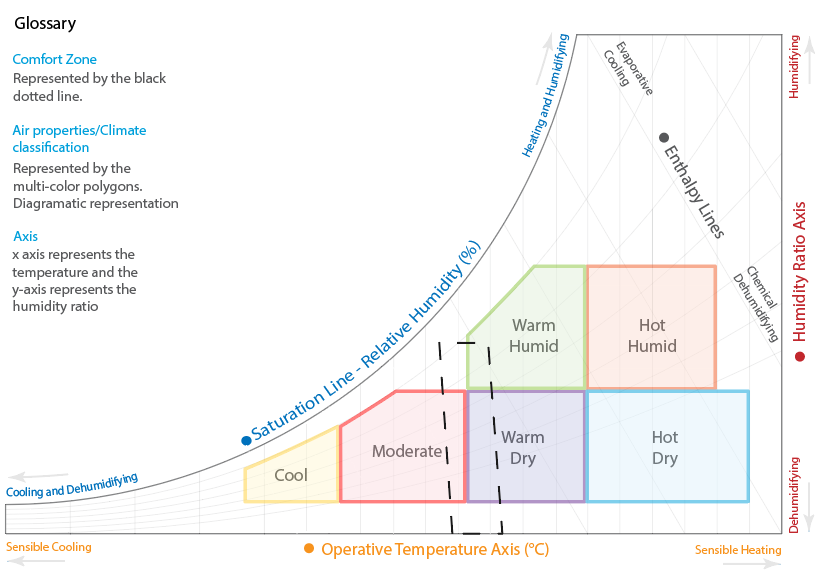
EXTRA 2